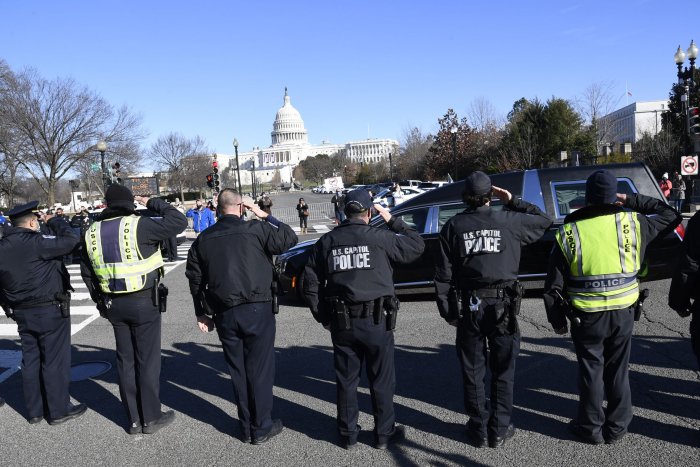1 of 5 | A statue of former President Zachary Taylor is covered with plastic obscuring a red substance on the face January 7, the day after rioters attacked the U.S. Capitol. File Photo by Ken Cedeno/UPI |
License Photo
Feb. 24 (UPI) -- A day after four law enforcement and security officers testified to the failures that facilitated the Jan. 6 attack on the U.S. Capitol, House lawmakers heard Wednesday from witnesses who say the rioters caused tens of thousands of dollars worth of damage to historical artifacts in the building.
Capitol architect Brett Blanton, House curator Farar Elliott and administrator Catherine Szpindor appeared before a subcommittee of the House appropriations committee on Wednesday morning.
Blanton told the committee that guarding historic items and the inside of the Capitol requires a comprehensive security assessment. He noted that since the Oklahoma City bombing in 1995, most plans have centered around prevention.
"When we look at a broader threat, it needs to be done in conjunction with our partners within the national capital area," he said.
The Capitol caretakers asked lawmakers for funds to repair objects located in the hallway that leads to the House chamber that were damaged by rioters.
Elliott said in her opening statement that some of the damaged items were covered, for example, with fire extinguisher residue.
"As the events of that day unfolded, I thought first for the safety of my colleagues in the clerk's office and the members and staff across the Hill," Elliott said in prepared remarks. "As the Capitol was secured that evening, my curatorial colleagues and I turned our attention to potential damage to the House collection and loans in the Capitol.
"During the riot, courageous staffers saved several important artifacts of the House's legislative history."
Elliott named some of the damaged items: marble and granite busts of former House Speakers Joe Cannon, Champ Clark, Joe Martin and Thomas Brackett Reed; portraits of former Presidents James Madison and John Quincy Adams; a bust of Chippewa leader Beshekee and a statue of former President Thomas Jefferson.
"We noted that they and their frames, plinths, pedestals and niches were covered in a fine powder, likely residue from a chemical spray," she said.
"The events of Jan. 6 were difficult for the American people, and extremely hard for all of us on campus to witness," Blanton said in his prepared statement. "As we continue to deal with the shock and disappointment of the actions of those who chose to attack the U.S. Capitol building, I remain proud of and encouraged by the professionalism displayed by [my] team in the face of this dangerous and stressful event.
"Statues, murals, historic benches and original shutters all suffered varying degrees of damage, primarily from pepper spray accretions and residue from chemical irritants and fire extinguishers. This damage to our precious artwork and statues will require expert cleaning and conservation."
Blanton asked the appropriations subcommittee to approve a $30 million transfer for his agency's expenses and to extend the perimeter fencing erected around the Capitol since Jan. 6.
On Tuesday, a joint meeting of two Senate committees heard testimony from four security officers about the failures that led to the assault and the chaos that followed.
Tuesday's hearing was the first public inquiry into the Capitol attack, which was organized and led by radical supporters of former President Donald Trump to disrupt Congress' certification of President Joe Biden's electoral win.
Blanton also told the subcommittee Wednesday the Capitol Police Board, of which he is a member, did not receive a request from Capitol police for additional resources in the days before the attack.
His testimony appeared to contradict comments made by acting Capitol Police Chief Yogananda Pittman, who said the board was asked for more help, but the request was rejected.
Blanton said he was not asked specifically for help and pointed to former Chief Steven Sund, who said Tuesday he went to the House and Senate sergeant-at-arms with his request.
He added that a meeting of law enforcement officials a day before the attack was mostly used to discuss roles and responsibilities for Biden's inauguration on Jan. 20.
"There was a little discussion about [Jan. 6]," he said. "Most of it that centered around there was no credible evidence, although there was chatter, of the events that may occur."
Pittman told the subcommittee last month said Sund requested the Capitol Police Board to declare a state of emergency days before Jan. 6, but was turned down. She said he was told then to contact the National Guard.
Blanton added that Sund went to the sergeants-at-arms about his concerns, but never asked the Capitol Police Board to declare a state of emergency. He also said the sergeants-at-arms never brought up their conversations with Sund to the board.
Military forces continue to guard the Capitol grounds and lawmakers plan to hold more investigative hearings into the attack. Many of the rioters have been arrested and charged with federal crimes. Trump was impeached for the second time for inciting an insurrection, but was acquitted in the Senate on the charge.
Capitol Hill police salute the passing of the funeral hearse on Sunday for slain Officer Brian Sicknick, who died in the rioting at the U.S. Capitol on Wednesday. Photo by Mike Theiler/UPI |
License Photo
















